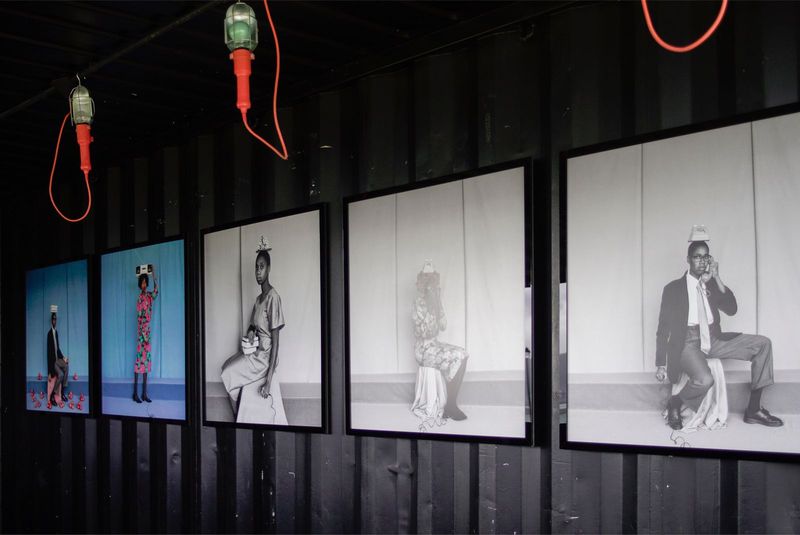Maria Ptqk on Getxophoto and Curating Photography in the Public Space
-
Published6 Feb 2024
-
Author
The curator offers insights on the selection process and the collaboration with PhMuseum that will soon bring another artist to exhibit at the Basque festival.
Since 2020, an applicant of the PhMuseum Photography Grant has been selected every year for a solo show at Getxophoto. After Silvia Rosi, Juliana Gómez Quijano and Alejandro "Luperca" Morales, Protege Noctem by Mattia Balsamini reached the underworld of Galerías Punta Begoña last year, his inquiry into the disappearance of the night becoming a physical, embodied experience. As this edition's deadline approaches, we touched base with Maria Ptqk to look into the process behind her work in Getxo.
Can you give us a glimpse of how the collaboration between you and the chosen artist usually runs? For example, what was the path that led to the way you exhibited Protege Noctem by Mattia Balsamini last year?
Last year, we had several viewing sessions of the PhMuseum 2023 Photography Grant projects and selected a few that we felt addressed our chosen theme (Pause) from different points of view. In the end we chose Mattia's because it spoke to us about the environment and also focused on the effects of light pollution on animals. At the same time, it coincided that we had a space where this work fitted well and could add another layer to Mattia's project. So, once we had a clear idea, we proposed it to the artist, who liked the proposal and the selection of images was made together. The idea is to establish a conversation with the chosen artist and present our ideas and the space we think is ideal for exhibiting the selected work.
What are your leading principles and thoughts when designing a show for the Festival?
We always keep in mind that Getxophoto is a festival that takes place mostly in the public space in the streets of Getxo, which is a small town on the Basque seaside, close to the city of Bilbao. Thus, the photographs merge with the urban landscape and the daily routines of the local population when they go to the post office or when they wait for the traffic light to get green, for example. That is why, when thinking about the program as a whole, we try to find the right balance between the artistic interest of the projects and their availability to fit properly into the space in which they are exhibited. We also tried to combine different genres and styles: portrait with documentary, analogue b&w with super contemporary images, etc. so that the festival reflects the current state of image creativity today.
Curating exhibitions for a festival is different from working in a gallery or museum. What have you found in this format and how do you think it can be beneficial for artists?
At the festival we show mostly outdoor displays but there are also indoor exhibitions. The main difference is that visitors to a gallery go there of their own free will and with a cultural purpose which means they are willing to devote time and attention to whatever is proposed to them within this framework. Whereas the exhibitions in the public space are more like an unexpected encounter: people don't always choose to go and see an exhibition, they just stumble upon it. And this is more exciting but also more demanding for the artwork because it is more difficult to arouse interest and have a memorable impact. So, artists receive another kind of feedback and understanding of their own work, not better or worse but definitely different and valuable.
What do you usually look for in a body of work, and what criteria or ideas do you follow when making your selection?
Besides the criteria I mentioned before, which apply to the festival as a whole, when I looking into a particular artwork I am very much guided by what could be called “the personality of the project” in the sense that, even if it's a subject or a genre that has been widely treated, there is a particular gaze or sensibility that makes this work unique, different from everything else. When I look into a project, I like to find the person behind it, not because it is a personal or autobiographical project but because the author's gaze is present and speaks to you.
Thinking of you as a spectator, is there one exhibition you have seen in your life that you think had an impact on your work as a curator? In general, how do you gather references and inspiration?
I don't want to sound too commonplace but honestly the world is an exhibition. We are surrounded by images that try to get our attention and tell us a story, and I’m not just talking about advertising which is obviously the main stage of visual imaginary nowadays. Everything that happens around us is a source of inspiration. So, working with images doesn't mean that your inspiration has to come only from visual material: all forms of art are a source of inspiration, but also all kind of practices, artistic or not, and from every period of history. I guess the key to a good curatorial gaze is to be able to develop a cultural understanding of reality in all its forms.
--------------
The PhMuseum Photography Grant has established itself as a leading prize in the industry over the last 12 years, renowned for recognising the importance of contemporary photography and for supporting emergent artists through cash prizes, exhibitions at international festivals, educational activities and exposure on online media. Among several institutions, Getxophoto will offer a new solo show to one work selected from our open call. You are welcome to present your work before 15 February 2024 at 11.59 pm (GMT). Learn more and apply at phmuseum.com/g24
Getxophoto is a festival focused on the image that has been held in Getxo -Basque Country- since 2007, created and managed by Begihandi. An initiative in continuous search of being more participative, committed and sustainable.










